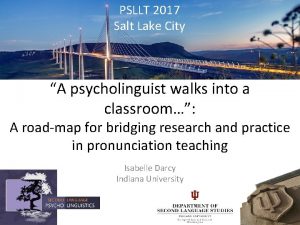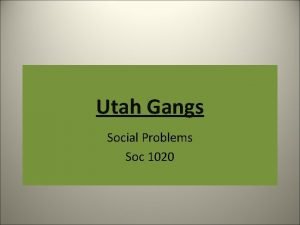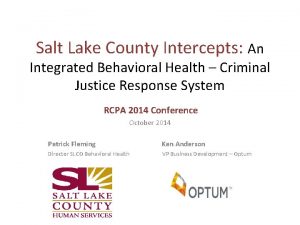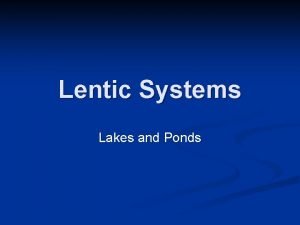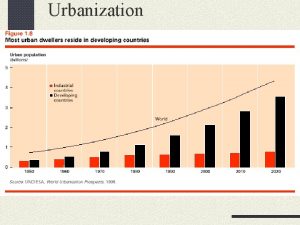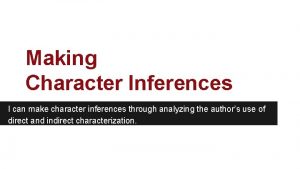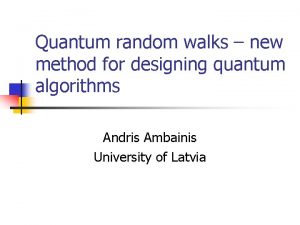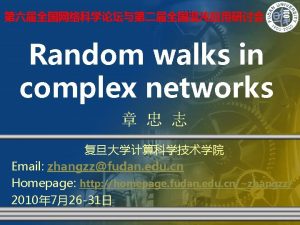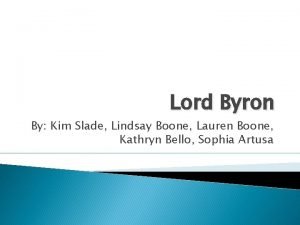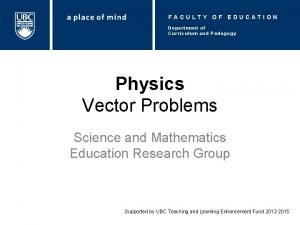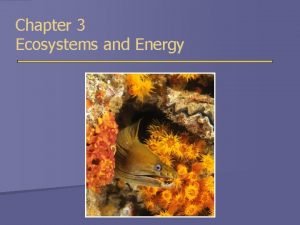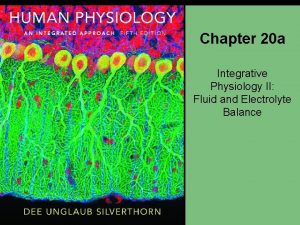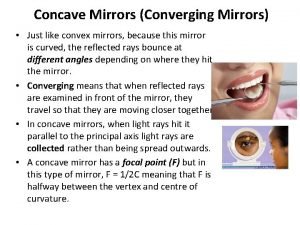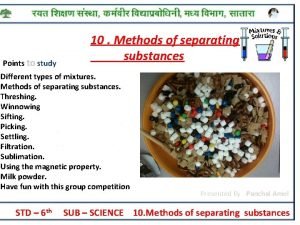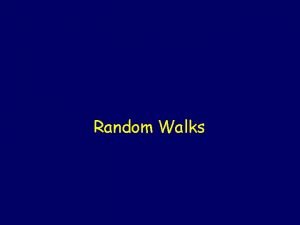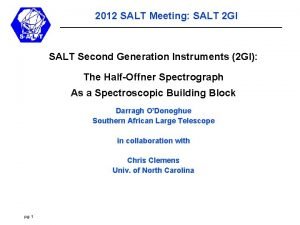PSLLT 2017 Salt Lake City A psycholinguist walks































































- Slides: 63

PSLLT 2017 Salt Lake City “A psycholinguist walks into a classroom…”: A road‐map for bridging research and practice in pronunciation teaching Isabelle Darcy Indiana University

Of bridges and gaps Bridging L 2 Pronunciation Research and Teaching • Very good topic • Bridges bridge gaps o In our specific field, the gap between research [on how learners learn the sound systems of their second language] and practice [pronunciation teaching and its role in fostering the learning of sound systems] • We don’t have a bridge currently • We don’t even have a “gap” – currently… The road toward bridging the gap PSLLT 2017 – Salt Lake City 2

“where is the other side? ” The road toward bridging the gap PSLLT 2017 – Salt Lake City Millau, © CEVM Eiffage 3

Psycholinguistics doesn’t “ask the right questions”! Teaching doesn’t take research findings into account! Is this true? The road toward bridging the gap PSLLT 2017 – Salt Lake City 4

Pronunciation teaching… • achieve accurate pronunciation o (= so that their production of sounds, stress, rhythm, and intonation begins to match an ideal pattern), • and use it fluently o (= automatically, without having to concentrate extremely), • in order to achieve comfortable intelligible pronunciation o (= speaking in a way that most listeners, both native and nonnative speakers, can understand without too much effort or confusion). Yoshida, Marla T. (2016) Beyond Repeat After Me: Teaching Pronunciation to English Learners. Tesol Press. Tesol International Association The road toward bridging the gap PSLLT 2017 – Salt Lake City 5

Some questions… Why • • • Does it work? Will it matter? Carry‐over? Automatization? Learners’ differences? How • • Which method? Diagnosis? Listening instruction? Perception? • Explicit feedback? • How much, how often? • Final and continuing assessment? Feedback, assessment What matters most? Right focus? Spelling? Which “standard” & what’s “correct”? • Critical pedagogy • • • Beginners? Advanced? • How long, how often? Whom, when

Psycholinguistics… • The study of the relationship between linguistic behavior and psychological processes, including the process of language acquisition • Is about understanding o o how children acquire language; how people process and comprehend language; how people produce language; how people acquire a new language (second language acquisition) Kantor, J. R. (1936). An objective psychology of grammar. Bloomington, IN: Indiana University Press, p. 55 f. The road toward bridging the gap PSLLT 2017 – Salt Lake City 7

Psycholinguistics: L 2 phonology… • • • Interfaces Representations Words? Phonological grammar? Segmental/suprasegmental categories? • Metalinguistic representations • Perception – lexical encoding – production? • L 1 – L 2 – L 3 interactions? • Oral & visual modalities? • Brain regions? • Brain efficiency? • Individual differences? Neural structures & functions • • Processing Access and use? Articulation, perception Segmentation? Word recognition? • Changes over time? • Which factors matter? (age, input. . . ) • Perceptual learning? • Laboratory training? • Instruction? Development

PRONUNCIATION INSTRUCTION AND L 2 PHONOLOGY RESEARCH

“Language is sound” Pronunciation is indissociable from the rest of language behavior • To make the language come alive requires the behaviors related to listening, speaking, reading and writing • Phonological, lexical, and structural knowledge lie at the heart of the language http: //languageinstinct. blogspot. com/2006/09/what-is-clt. html The road toward bridging the gap PSLLT 2017 – Salt Lake City 10

Picture: Courtesy of Ryan Lidster; taken in Jerusalem And that’s how… One goal of pronunciation instruction is to help learners with the form of words! The road toward bridging the gap PSLLT 2017 – Salt Lake City 11

And yet… • Teachers and researchers do not know what to do with research findings when it comes to teaching pronunciation o Not enough research about pronunciation instruction (Gordon, 2015) and the effectiveness of specific methods to enhance intelligibility (Derwing & Munro, 2015, ch. 5) • Research in L 2 phonology focuses on accuracy • Unfortunately, the effects of instruction have never been much of a focus o Example: speech perception research The road toward bridging the gap PSLLT 2017 – Salt Lake City 12

Luckily there’s PSLLT ! • This is changing (e. g. JSLP; Linda Grant, ed. , 2014; Derwing & Munro, 2015; Isaacs and Trofimovich, eds. , 2017; Reed & Levis, eds. , 2016; or Levis & Munro, eds. , 2017: 4‐volume series on pronunciation…) • Since Joan Morley‘s call for research on L 2 phonology and on the effects of instruction (Morley, 1991)… o Much work done in L 2 phonology o Research on pronunciation instruction is a quickly growing field The road toward bridging the gap PSLLT 2017 – Salt Lake City 13

Is L 2 phonology relevant to pronunciation teaching? • Focus on accuracy o How learners learn something, how fast, … how different are they from native speakers • vs. Focus on intelligibility • Indirectly o Can guide priorities and diagnosis o Can highlight factors that facilitate learning o Can serve as a road map for research The road toward bridging the gap PSLLT 2017 – Salt Lake City 14

Two psycholinguistic areas • The mental lexicon, the learning of the phonological form of words (“phono‐lexical” acquisition), and spoken word recognition o Pronunciation, vocabulary, listening • The role of individual differences in cognitive abilities o Intersections with L 2 phonology and instruction The road toward bridging the gap PSLLT 2017 – Salt Lake City 15

1. THE MENTAL LEXICON

Word recognition in fluent speech Conceptual, syntactic, orthographic codes • Map the incoming speech signal onto lexical representations stored in memory Lexical Selection & Access (Mc. Clelland & Elman, 1986; Norris, 1994) “. . . the unfolding information in an acoustic stream of temporally distributed information is mapped onto one of thousands of representations in memory” (Jusczyk & Luce 2002, p. 12) /lu: k/ /li: k/ /lɪk/ /lɑg/ /lɑk/ /rɑk/ Prelexical code [lɑk] Phonetic decoding Acoustic code …lɑk… (Mc. Queen, Cutler, & Norris, 2006) The road toward bridging the gap PSLLT 2017 – Salt Lake City 17

The problem #1 • The problem is that this unfolding information looks like this: (Hockett 1955, p. 210) • Variability in speech due to coarticulation during production, phonological processes, etc. is a problem • The task of the hearer is to identify the ‘word units’ The road toward bridging the gap PSLLT 2017 – Salt Lake City 18

Competition from phantom words • For Dutch listeners (L 2 English): Non‐words (*groof) can be recognized as words (groove) • Do embedded non‐words enter the competition process as words for L 2 learners? • Would a sequence like “big roof“ prime the word groove? Cutler, 2005 Yes, they do: Broersma & Cutler, 2008 “The pronunciation of near-words such as groof in real speech contexts such as big roof is just as capable of activating groove for a L 2 listener as the isolated form groof. These contexts cause phantom word activation for L 2 listeners, while L 1 listeners experience no such effect. ” (p. 29) The road toward bridging the gap PSLLT 2017 – Salt Lake City 19

The problem #2: lexical representations • And the other problem is that the representations in the mind of the (L 2) listener might look like this: Cook & Gor, 2015; Darcy et al. , 2012; Darcy, Daidone & Kojima, 2013; Escudero, Hayes-Harb & Mitterer, 2008; Pajak, Creel & Levy 2016; Pallier et al. , 2001; Trofimovitch & John, 2011; Weber & Cutler 2004 … The road toward bridging the gap PSLLT 2017 – Salt Lake City 20

Speeded Auditory Lexical Decision Japanese Is it a real _____ word? German Spanish French Russian English … PROBING PHONOLEXICAL REPRESENTATIONS Yes/No

Similar findings with L 2 German and L 2 Japanese: Darcy, Daidone & Kojima (2013) The Mental Lexicon Consonants L 2 Russian Lexical decision (error %) Palatalized / Plain consonants Learners: Very high error rates on test nonwords e. g. [stolj] treated as a real word [palatalized] [sj] [tj] [nj] [lj] [rj] … [plain] [s] [t] [n] [l] [r] … L 1 English [N = 40] Word Non Word Intermediate [< 3 years instr. , N = 20] stol *stolj solʲ Advanced [> 4 years instr. , N = 20] ‘table’ ‘salt’ Test items Russian. Control Nativeitems Speakers [N*stor = 10] Non Word *sol *somj Auditory word‐picture matching Simonchyk & Darcy (2017) PSLLT Proceedings The road toward bridging the gap PSLLT 2017 – Salt Lake City 22

Across the whole phonological system Suprasegmentals Syllable structure Dupoux, E. , Sebastián‐Gallés, N. , Navarrete, E. , & Peperkamp, S. (2008). Cognition. Word stress is contrastive in Spanish, not in French: [sabana] ‘savannah’ ‐ [sábana] ‘sheet’; Example stimuli: Onset clusters exist in English (“blue”, “play”), not in Korean. They are perceptually repaired with [ʊ] epenthesis: b[ʊ]lue (Kabak & Idsardi, 2007; Dupoux et al. , 1999) górro is a word (‘hat’) gorró is not Lexical decision task (180 trials) Lexical decision task French L 2 learners: ~ 60% error for test non-words (all groups) The road toward bridging the gap Darcy & Thomas (submitted) Test u: [bʊ'lu: ] ‐‐ [pʊ'leɪ] Control i: [bɪ'lu: ] ‐‐ [pɪ'leɪ] Filler words + nonwords Learners: ~ 40% error for [bʊ'lu: ] items (up to 80%), not for control i. PSLLT 2017 – Salt Lake City 23

What does this all mean? • Word recognition in a second language is less selective o Competition from both lexicons, unnecessary competitors • Lexical representations reflect L 1‐based phonology o L 1‐based processing across the whole system • Lexical effects can persist independently of improvements in learners’ perception (e. g. Darcy, Daidone & Kojima, 2013; Darcy et al. , 2012) o Reliable perception helps but does not guarantee accurate lexical encoding (Simonchyk, 2017) o Representations are also fuzzy even with easy contrasts (Cook & Gor, 2015; Cook, Pandža, Lancaster, & Gor, 2016) The road toward bridging the gap PSLLT 2017 – Salt Lake City 24

INTERESTING! BUT WHY DO WE CARE?

Why do lexical representations matter? • Vocabulary knowledge: less ambiguity between words • Production: higher intelligibility (syllable structure, stress patterns, consonants) o Production accuracy correlates with lexical accuracy (Simonchyk, 2017) o For automatized retrieval under constrained resources • Listening: Recognizing words more easily o By reducing competition The road toward bridging the gap PSLLT 2017 – Salt Lake City 26

PHONO‐LEXICAL ACQUISITION Vocabulary Connected speech training Bimodal input: audio + written input THREE (PROMISING) DIRECTIONS WORD RECOGNITION (listening, processing)

http: //rstb. royalsocietypublishing. org/content/364 /1536. cover-expansion The road toward bridging the gap Vocabulary PSLLT 2017 – Salt Lake City 28

Acquiring new words “A lexical entry in the lexicon of the average adult, literate, native speaker contains semantic, pragmatic, stylistic, collocational, syntactic, categorial, morphological, phonological, articulatory and orthographic features. ” (Hulstijn 2001, p. 259) Mappings (Barcroft, 2015) WORD FORM MEANING USE The road toward bridging the gap PSLLT 2017 – Salt Lake City 29

Retention through elaboration phonological articulatory orthographic morphological word WORD pragmatic stylistic syntactic semantic (Hulstijn & Laufer, 2001, 541‐ 542; Hulstijn, 2001; Nation & Newton, 1997) The road toward bridging the gap PSLLT 2017 – Salt Lake City 30

Retention through elaboration + repetition phonological articulatory orthographic morphological WORD pragmatic stylistic syntactic semantic Ø Reactivation and repetition are needed for automaticity in lexical access The road toward bridging the gap Kimppa, 2017; Nation & Newton, 1997 PSLLT 2017 – Salt Lake City 31

Effective instruction: dual focus Repetition in retrieval recycling… of familiar materials Ø automaticity www. You. Glish. com UTube Picture matching Word matching… vocabulary pronunciation Elaboration Authenticity Communicative, meaning‐oriented activities Ø transfer Automaticity + Carryover = Effective instruction PHONO ‐LEXICAL ACQUISITION? Gatbonton & Segalowitz, 1988; Trofimovich & Gatbonton, 2006 The road toward bridging the gap PSLLT 2017 – Salt Lake City 32

Whatcha doing? ? ? Connected Speech Training The road toward bridging the gap PSLLT 2017 – Salt Lake City 33

Why connected speech training? Ladefoged, A course in Phonetics (http: //hctv. humnet. ucla. edu/departments/linguistics/Vowelsand. Consonants/course/chapter 5 ) The road toward bridging the gap PSLLT 2017 – Salt Lake City 34

Gökgöz-Kurt, B. (2016) Attention Control and the Effects of Online Training in Improving Connected Speech Perception by English as a Second Language Learners. Unpublished Ph. D. Dissertation, Univ. of South Carolina. Gökgöz-Kurt’s Dissertation (2016) They all could use [dʒuz] any of these. They all could choose [tʃuz] any of these • • received online training and explicit instruction for 3 weeks (60 mins in total) Between-word palatalization Control: 4 Control classes (N = 25) did the “normal” curriculum Two-option forced-choice perception test • • • Pre-test and post-test Max. score = 44. All items were different from those in online training modules The road toward bridging the gap Treatment (n = 33) 3. 5 Gains (points) from pre-test to post-test Treatment: 4 Experimental classes (N = 33) Control (n = 25) 3 2. 5 (p =. 007) 2 1. 5 1 2. 81 0. 5 0 PSLLT 2017 – Salt Lake City 0. 68 35

Summary • Online training works! o (on an immediate forced‐choice perception post‐test) • Connected speech can be taught usefully o See also Cauldwell, 2013 Ø More research needed to know if this might generalize to listening in communicative situations WORD RECOGNITION (listening, processing) The road toward bridging the gap PSLLT 2017 – Salt Lake City 36

Laura (Otto Preminger, 1944). Bi-modal input The road toward bridging the gap PSLLT 2017 – Salt Lake City 37

Bi-modal input? WORD RECOGNITION (listening, processing) • Variation, reductions, connected speech, unfamiliar dialect or accent are challenging (Connine, Blasko, & Titone, 1993; Sumner & Samuel, 2005; Floccia et al. , 2006; Ikeno & Hansen, 2007; Tamati, 2014; Schmidt, 2009) • Word identification in continuous speech produced by native speakers, is difficult in L 2, even when all individual words are familiar (Brown, 1990) • The combination of written + audio input has the potential to help develop word recognition and segmentation skills by making input more intelligible (Levi, Winters & Pisoni, 2007; Mitterer & Mc. Queen, 2009; Escudero, Hayes‐Harb & Mitterer, 2008; Showalter and Hayes‐ Harb, 2013) The road toward bridging the gap PSLLT 2017 – Salt Lake City 38

Bi-modal input studies & listening • Overall positive influence of captioned (vs. non captioned) media on comprehension (e. g. television Teletext captions, Vanderplank, 1988; Markham, 1989; Markham et al. , 2001; Winke et al. , 2010; Montero‐Perez et. al. ’s meta‐analysis, 2013) • What about segmentation and word recognition? o Written measures; No control group without sound Ø Is it really because of improved *segmentation* and word recognition skills? Or just due to the fact that they have a text and can read, even without listening? The road toward bridging the gap PSLLT 2017 – Salt Lake City 39

(More) Research is needed • Markham (1999) used a listening multiple choice • Charles and Trenkic (2015): improvements due to better segmentation skills, and not *just* to the fact that learners were provided with written input o Good assessment task for lexical access and segmentation via shadowing (Mitterer & Mc. Queen 2009) o Good controls (“No sound” group!) o Generalization to new utterances and new speakers Charles, T. and Trenkic, D. (2015). Speech Segmentation in a Second Language: The Role of Bi-modal Input. In: Y. Gambier, A. Caimi & C. Mariotti (eds. ) Subtitles and Language Learning (pp. 173 -197). Bern: Peter Lang. The road toward bridging the gap PSLLT 2017 – Salt Lake City 40

See also Wisniewska & Mora talk, Friday, 12: 00 pm: PHONO‐LEXICAL ACQUISITION? WORD RECOGNITION (listening, processing) Charles and Trenkic (2015): Results Proportion correctly repeated words Group * Time Interaction Bimodal group outperformed other groups in all cases, for all items: • old items, • new items and • brand-new items N = 12 Conclusion: captions helped with segmentation of spoken input, and the effect really is about *spoken input*, not about general comprehension. The road toward bridging the gap PSLLT 2017 – Salt Lake City 41

2. EXECUTIVE FUNCTIONS AND INDIVIDUAL DIFFERENCES

Executive functions • Higher‐level cognitive skills we use to control and coordinate our other cognitive abilities and behaviors • Attention control (AC) (Segalowitz & Frenkiel‐Fishman, 2005) o Cocktail‐party effect o Noticing (Mora & Gilabert, 2012; Safronova & Mora, 2013) o idea as [aidi: ] or consequence as “con. SEquence” The road toward bridging the gap PSLLT 2017 – Salt Lake City 43

Executive functions • Higher‐level cognitive skills we use to control and coordinate our other cognitive abilities and behaviors • Attention control (AC) (Segalowitz & Frenkiel‐Fishman, 2005) o Cocktail‐party effect o Noticing (Mora & Gilabert, 2012; Safronova & Mora, 2013) o idea as [aidi: ] or consequence as “con. SEquence” • Inhibition skill (Friedman and Miyake 2004; Lev‐Ari & Peperkamp, 2013) o Suppress an automatic response, resist interference o Reduce L 1‐based processing The road toward bridging the gap PSLLT 2017 – Salt Lake City 44

Executive functions and L 2 phonology • Complex relationship (Darcy, Mora & Daidone, 2016) (Darcy et al. , 2015; Trofimovich & Gatbonton, 2006) working memory (O’Brien et al. , 2007) inhibition (Gökgöz‐Kurt, 2016) (Garcia‐Amaya, 2012) attention control L 2 FLUENCY & PHONOLOGICAL PROCESSINGL 2 ACCURACY LEARNING (GAIN SCORES) • Relationships are multiple, modest (will we ever explain > 20% of variance? ), depend on task demands and learning contexts (e. g. Darcy & Mora, 2017) and need further research! • What about causality relationships? Need the research! The road toward bridging the gap PSLLT 2017 – Salt Lake City 45

Connected speech processing and attention control Significant negative correlations: • The more efficient the attention control, the more gains were made between the pre-and Burcu Gökgöz‐Kurt’s Ph. D. Dissertation (2016) post-test (connected speech perception task) o Does explicit training lead to gains in connected speech perception? o Is there a relationship between students’ gain scores and their attention control? • a) Attention Network Test (ANT) (Fan, et al. , 2002; Weaver, Bédard, & Mc. Auliffe, 2009, 2013) [conflict effect] • b) Speech‐Based Attention Switching Task (Mora & Darcy, 2017; Darcy, Park & Yang, 2015) [switch cost effect] Ø If there is a relationship (more efficient attention control and gains on the listening task), we expect negative correlations Ø more efficient attention control is indexed by smaller values of effect The road toward bridging the gap PSLLT 2017 – Salt Lake City 46

AGAIN: COOL STUFF BUT…

Executive functions relate to L 2 phonological processing Higher executive functioning more accurate pronunciation and phonological processing Potentially important consequences for teaching and learning pronunciation isolated dimensions of phonological systems, not intelligibility What is the role of executive functions for developing intelligibility? The road toward bridging the gap PSLLT 2017 – Salt Lake City 48

Do executive functions relate to pronunciation instruction? • Match between learners’ abilities and instruction (Snow 1989) • When learners’ attention is drawn to phonological elements, it helps (indirect evidence). For example: o Explicit instruction (Derwing, Munro & Wiebe, 1998; Gordon, Darcy & Ewert, 2013) o Corrective feedback (Hardison, 2004; Saito, 2011) o High variability training studies (Bradlow et al. , 1997; Wang et al. , 2003) o Heightened phonological awareness relates to higher pronunciation ratings (Kennedy & Trofimovich, 2010), and is perhaps driven by phonological memory (Venkatagiri & Levis, 2007). • Supports direct link between attention skills and explicit pronunciation teaching (see previous studies) => but we need the research! The road toward bridging the gap PSLLT 2017 – Salt Lake City 49

Bean Blossom Bridge Brown County, Indiana Outline for a road-map … A DOUBLE AGENDA

We need foundations • About all aspects of L 2 phonology acquisition and processing (see Morley, 1991) o Phonological grammar (all areas of phonological knowledge: segments, phonotactics, suprasegments) Ø Mental lexicon, perception, production => intelligibility o Listening to reduced and conversational speech o Individual differences in executive functions • About instruction and acquisition (see Morley, 1991) o How, what, when, why, and assessment The road toward bridging the gap PSLLT 2017 – Salt Lake City 51

And the bridge… • To what extent can instruction actually shape L 2 acquisition: o help with updating lexical representations? o help with word recognition in conversation? o facilitate perception development? o help automatize articulatory routines? Ø lead to actual transfer and automatization? Intelligibility? Listening? • Which kind of instruction can do this, and why/how? o how much, how often, and how early? The road toward bridging the gap PSLLT 2017 – Salt Lake City 52

1. The mental lexicon Vocabulary instruction ? includes attention to FORM PHONO‐LEXICAL ACQUISITION ? Connected speech training ? WRITING WORD RECOGNITION (listening, processing) ? Bimodal input approaches The road toward bridging the gap PSLLT 2017 – Salt Lake City 53

2. Individual differences • What is the link between executive functions (EF) and intelligibility? • Would learners with higher EF‐scores benefit more from explicit pronunciation instruction? (Trofimovich & Gatbonton, 2006) What about others? Enter the domain of science “fiction”… • Turning it around: can we train EF for some learners? (Jaeggi et al. , 2011 and cognitive training approaches) • Alternatively: Can we tailor instruction to make it more usable and beneficial for a variety of learners? (Snow, 1989) o e. g. by having more attention‐directing activities for those learners who have difficulties with attention focusing The road toward bridging the gap PSLLT 2017 – Salt Lake City 54

Let’s keep working! The road toward bridging the gap PSLLT 2017 – Salt Lake City Grand Canyon, Arizona Photo by Claire Renaud 55

56 THANK YOU! Isabelle Darcy: idarcy@indiana. edu and… Aileen Bach Spring 2016 Danielle Daidone Doreen Ewert Burcu Gökgöz-Kurt Joshua Gordon Chisato Kojima Franziska Krüger Ryan Lidster Miguel Marquez Joan C. Mora Vance Schaefer John Scott Ala Simonchyk Chung-Lin Yang Second Language Psycholinguistics Lab http: //www. iub. edu/~psyling/

REFERENCES

Barcroft, J. (2015) Lexical Input Processing and Vocabulary Learning. Amsterdam, Philadelphia: John Benjamins Bradlow, A. R. , Pisoni, D. B. , Akahane‐Yamada, R. , & Tohkura, Y. (1997). Training Japanese listeners to identify English /r/ and /l/: IV. Some effects of perceptual learning on speech production. Journal of the Acoustical Society of America, 101, 2299‐ 2310. Broersma, M. , & Cutler, A. (2008). Phantom word activation in L 2. System, 36, 22‐ 34. Brown, G. (1990). Listening to Spoken English. London: Longman. Cauldwell, R. (2013). Phonology for Listening: Teaching the Stream of Speech. Birmingham, UK: Speech in Action. Charles, T. and Trenkic, D. (2015). Speech Segmentation in a Second Language: The Role of Bi‐modal Input. In: Y. Gambier, A. Caimi & C. Mariotti (Eds. ) Subtitles and Language Learning (pp. 173‐ 197). Bern: Peter Lang. Connine, C. M. , Blasko, D. G. , & Titone, D. (1993). Do the beginnings of spoken words have a special status in auditory word recognition? Journal of Memory and Language, 32, 193‐ 210. doi: 10. 1006/jmla. 1993. 1011 Cook, S. V. , & Gor, K. (2015). Lexical access in L 2: Representational deficit or processing constraint? The Mental Lexicon, 10, 247‐ 270. doi: 10. 1075/ml. 10. 2. 04 coo Cook, S. V. , Pandža, N. B. , Lancaster, A. K. , & Gor, K. (2016). Fuzzy Nonnative Phonolexical Representations Lead to Fuzzy Form‐to‐ Meaning Mappings. Frontiers in Psychology, 7 (1345). doi: 10. 3389/fpsyg. 2016. 01345 Cutler, A. (2005). The lexical statistics of word recognition problems caused by L 2 phonetic confusion. In Proceedings of Interspeech 2005 (pp. 413‐ 416), 9 th European Conference on Speech Communication and Technology, Lisbon, Portugal, September 4‐ 8, 2005. Available at ISCA Archive, http: //www. isca‐speech. org/archive/interspeech_2005 Darcy, I. , Daidone, D. , & Kojima, C. (2013). Asymmetric lexical access and fuzzy lexical representations in second language learners. The Mental Lexicon, 8, 372‐ 420. Darcy, I. , Dekydtspotter, L. , Sprouse, R. A. , Glover, J. , Kaden, C. , Mc. Guire, M. , & Scott, J. H. (2012). Direct mapping of acoustics to phonology: On the lexical encoding of front rounded vowels in L 1 English–L 2 French acquisition. Second Language Research, 28, 5‐ 40. Darcy, I. & Mora, J. ‐C. (2017) Executive control and phonological processing in balanced and unbalanced bilinguals. In Gisela Grañena, Daniel O. Jackson, and Yucel Yilmaz (Eds). Cognitive Individual Differences in L 2 Processing and Acquisition (pp. 249‐ 277). John Benjamins (Bilingual Processing and Acquisition series) Darcy, I. , Mora, J. C. , & Daidone, D. (2016). The Role of Inhibitory Control in Second Language Phonological Processing. Language Learning, 66, 741‐ 773. doi: 10. 1111/lang. 12161 Darcy, I. , Park, H. , & Yang, C. (2015). Individual differences in L 2 acquisition of English phonology: The relation between cognitive abilities and phonological processing. Learning and Individual Differences, 40, 63‐ 72. doi: http: //dx. doi. org/10. 1016/j. lindif. 2015. 04. 005 The road toward bridging the gap PSLLT 2017 – Salt Lake City 58

Derwing, T. M. & Munro, M. (2015) Pronunciation Fundamentals. Evidence-based perspectives for L 2 teaching and research. Amsterdam: John Benjamins Publishing Company. Derwing, T. M. , Munro, M. , & Wiebe, G. (1998). Evidence in favor of a broad framework for pronunciation instruction. Language Learning, 48, 393‐ 410. Dupoux, E. , Kakehi, K. , Hirose, Y. , Pallier, C. , & Mehler, J. (1999). Epenthetic vowels in Japanese: A perceptual illusion? Journal of Experimental Psychology: Human Perception and Performance, 25, 1568‐ 1578. Dupoux, E. , Sebastián‐Gallés, N. , Navarrete, E. , & Peperkamp, S. (2008). Persistent stress 'deafness': The case of French learners of Spanish. Cognition, 106, 682‐ 706. Escudero, P. , Hayes‐Harb, R. , & Mitterer, H. (2008). Novel second‐language words and asymmetric lexical access. Journal of Phonetics, 36, 345‐ 360. Fan, J. , Mc. Candliss, B. D. , Sommer, T. , Raz, A. , & Posner, M. I. (2002). Testing the efficiency and independence of attentional networks. Journal of Cognitive Neuroscience, 14, 340‐ 347. Floccia, C. , Goslin, J. , Girard, F. , & Konopczynski, G. (2006). Does a regional accent perturb speech processing? Journal of Experimental Psychology: Human Perception and Performance, 32, 1276‐ 1293. Friedman, N. P. , & Miyake, A. (2004). The relations among inhibition and interference control functions: A latent‐variable analysis. Journal of Experimental Psychology: General, 133, 101– 135. doi: 10. 1037/0096‐ 3445. 133. 1. 101 Garcia‐Amaya, L. (2012). Second Language Fluency and Cognition: The Study of Spanish Second Language Development in an Overseas Immersion Program and an At-Home Foreign Language Classroom. Unpublished Ph. D. Dissertation, Indiana University Bloomington. Gatbonton, E. , & Segalowitz, N. (1988). Creative Automatization: Principles for Promoting Fluency Within a Communicative Framework. TESOL Quarterly, 22, 473‐ 492. Gökgöz‐Kurt, B. (2016) Attention Control and the Effects of Online Training in Improving Connected Speech Perception by English as a Second Language Learners. Unpublished Ph. D. Dissertation, Univ. of South Carolina. Gordon, J. , Darcy, I. , & Ewert, D. (2013). Pronunciation teaching and learning: Effects of explicit phonetic instruction in the L 2 classroom. In J. Levis & K. Le. Velle (Eds. ), Proceedings of the 4 th Pronunciation in Second Language Learning and Teaching Conference (pp. 194– 206). Iowa State University. The road toward bridging the gap PSLLT 2017 – Salt Lake City 59

Gordon, J. (2015). Teaching and Learning L 2 Pronunciation: A Closer Look at Classroom and Extra-Classroom Factors in the Development of Comprehensibility in ESL Learners. Unpublished Ph. D. Dissertation, Indiana University Bloomington. Hardison, D. M. (2004). Generalization of computer‐assisted prosody training: Quantitative and qualitative findings. Language Learning & Technology, 8, 34‐ 52. Hockett, C. F. (1955). A Manual of Phonology. Baltimore, MD: Waverly Press Hulstijn, J. (2001). Intentional and incidental second‐language vocabulary learning. In P. Robinson (Ed. ), Cognition and Second Language Instruction (pp. 258‐ 286). Cambridge: Cambridge University Press. Ikeno, A. , & Hansen, J. H. L. (2007). The Effect of Listener Accent Background on Accent Perception and Comprehension. EURASIP Journal on Audio, Speech, and Music Processing, 2007, 1‐ 8. Isaacs, T. & Trofimovich, P. , Eds. (2017) Second Language Pronunciation Assessment: Interdisciplinary Perspectives. Bristol: Multilingual Matters Jaeggi, S. M. , Buschkuehl, M. , Jonides, J. , & Shah, P. (2011). Short‐ and long‐term benefits of cognitive training. Proceedings of the National Academy of Sciences, 108, 10081‐ 10086. doi: 10. 1073/pnas. 1103228108 Jusczyk, P. W. , & Luce, P. A. (2002). Speech Perception and Spoken Word Recognition: Past and Present. Ear and Hearing, 23, 2‐ 40. Kabak, B. , & Idsardi, W. J. (2007). Perceptual Distortions in the Adaptation of English Consonant Clusters: Syllable Structure or Consonantal Contact Constraints? Language & Speech, 50, 23‐ 52. Kantor, J. R. (1936). An objective psychology of grammar. Bloomington, IN: Indiana University Press. Kennedy, S. , & Trofimovich, P. (2010). Language awareness and second language pronunciation: a classroom study. Language Awareness, 19, 171‐ 185. Kimppa, L. (2017) Rapid formation and activation of lexical memory traces in human neocortex. Unpublished Ph. D. Dissertation, University of Helsinki, Finland Hulstijn, J. H. , & Laufer, B. (2001). Some Empirical Evidence for the Involvement Load Hypothesis in Vocabulary Acquisition. Language Learning, 51, 539‐ 558. doi: 10. 1111/0023‐ 8333. 00164 Lev‐Ari, S. , & Peperkamp, S. (2013). Low inhibitory skill leads to non‐native perception and production in bilinguals' native language. Journal of Phonetics, 41, 320‐ 331. The road toward bridging the gap PSLLT 2017 – Salt Lake City 60

Levi, S. V. , Winters, S. J. , & Pisoni, D. B. (2007). Speaker‐independent factors affecting the perception of foreign accent in a second language. The Journal of the Acoustical Society of America, 121, 2327‐ 2338. Levis, J. & Munro, M. , Eds. (2017) Pronunciation: Critical Concepts in Linguistics (4 volumes). Routledge/Taylor and Francis. Grant, L. (2014). Ed. Pronunciation myths: Applying second language research to classroom teaching. (pp. 1‐ 33) Ann Arbor: University of Michigan Press. Markham, P. (1989). The effects of captioned television videotapes on the listening comprehension of beginning, intermediate and advanced ESL students. Educational Technology, 29, 38‐ 41. Markham, P. (1999). Captioned videotapes and second‐language listening word recognition. Foreign Language Annals, 321‐ 328. Markham, P. , Peter, L. , Mc. Carthy, T. (2001). The effects of native language vs. target language captions on foreign language students’ DVD video comprehension. Foreign Language Annals, 34, 439‐ 445. Mitterer, H. , & Mc. Queen, J. M. (2009). Foreign Subtitles Help but Native‐Language Subtitles Harm Foreign Speech Perception. PLOS ONE, 4(11), e 7785. doi: 10. 1371/journal. pone. 0007785 Montero Perez, M. , Van Den Noortgate, W. , & Desmet, P. (2013). Captioned video for L 2 listening and vocabulary learning: A meta‐analysis. System, 41, 720‐ 739. doi: http: //dx. doi. org/10. 1016/j. system. 2013. 07. 013 Mc. Clelland, J. L. , & Elman, J. L. (1986). The TRACE Model of Speech Perception. Cognitive Psychology, 18, 1‐ 86. Norris, D. (1994). Shortlist: a connectionist model of continuous speech recognition. Cognition, 52, 189‐ 234. Mc. Queen, J. M. , Cutler, A. , & Norris, D. (2006). Phonological Abstraction in the Mental Lexicon. Cognitive Science, 30, 1113‐ 1126. Mora, J. C, & Darcy, I. (2017). The relationship between cognitive control and pronunciation in a second language. In T. Isaacs & P. Trofimovich (Eds. ), Second Language Pronunciation Assessment: Interdisciplinary Perspectives (pp. 95‐ 120). Bristol: Multilingual Matters. Mora, J. C. & Gilabert, R. (2012). Individual factors in utterance and perceived fluency: some empirical issues. Workshop Fluent Speech: Combining cognitive and educational approaches. University of Utrecht, the Netherlands. Morley, J. (1991). The Pronunciation component in teaching English to speakers of other languages. TESOL Quarterly, 25, 114‐ 153. Nation, P. , & Newton, J. (1997). Teaching vocabulary. In: J. Coady & T. Huckin (Eds. ), Second Language Vocabulary Acquisition: A Rationale for Pedagogy (pp. 238‐ 254). Cambridge, UK: Cambridge University Press. The road toward bridging the gap PSLLT 2017 – Salt Lake City 61

O'Brien, I. , Segalowitz, N. , Freed, B. F. , & Collentine, J. (2007). Phonological memory predicts second language oral fluency gains in adults. Studies in Second Language Acquisition, 29, 557‐ 582. Pajak, B. , Creel, S. C. , & Levy, R. (2016). Difficulty in learning similar‐sounding words: A developmental stage or a general property of learning? Journal of Experimental Psychology: Learning, Memory, and Cognition, 42, 1377‐ 1399. doi: 10. 1037/xlm 0000247 Pallier, C. , Colomé, A. , & Sebastian‐Gallés, N. (2001). The influence of native‐language phonology on lexical access: exemplar‐ based versus abstract lexical entries. Psychological Science, 12, 445‐ 449. Reed, M. & Levis, J. , Eds. (2016) The Handbook of English Pronunciation (pp. 471‐ 487). Hoboken, NJ: John Wiley & Sons, Inc. Safronova, E. , & Mora, J. C. (2013). Attention control in L 2 phonological acquisition. In A. Llanes Baró, L. Astrid Ciro, L. Gallego Balsà, & R. M. Mateus Serra (Eds. ), Applied linguistics in the age of globalization (pp. 384– 390). Lleida, Spain: Edicions de la Universitat de Lleida. Saito, K. (2011). Examining the role of explicit phonetic instruction in native‐like and comprehensible pronunciation development: an instructed SLA approach to L 2 phonology. Language Awareness, 20, 45‐ 59. doi: 10. 1080/09658416. 2010. 540326. Schmidt, L. B. (2009). The Effect of Dialect Familiarity via a Study Abroad Experience on L 2 Comprehension of Spanish. Selected Proceedings of the 11 th Hispanic Linguistics Symposium, ed. Joseph Collentine et al. , 143‐ 154. Somerville, MA: Cascadilla Proceedings Project. Segalowitz, N. , & Frenkiel‐Fishman, S. (2005). Attention control and ability level in a complex cognitive skill: Attention shifting and second‐language proficiency. Memory and Cognition, 33, 644‐ 653. Showalter, C. , & Hayes‐Harb, R. (2013). Unfamiliar orthographic information and second language word learning: A novel lexicon study. Second Language Research, 29, 185‐ 200. Simonchyk, A. & Darcy, I. (2017) Lexical encoding and perception of palatalized consonants in L 2 Russian. In M. O’Brien & J. Levis (Eds). Proceedings of the 8 th Pronunciation in Second Language Learning and Teaching Conference, ISSN 2380‐ 9566, Calgary, AB, August 2016 (pp. 121‐ 132). Ames, IA: Iowa State University. Simonchyk, A. (2017). The relationships between perception, production, lexical encoding and orthography in the acquisition of palatalization in L 2 Russian. Unpublished Ph. D. Dissertation, Indiana University Bloomington. The road toward bridging the gap PSLLT 2017 – Salt Lake City 62

Snow, R. E. (1989). Aptitude treatment interaction as a framework for research on individual differences in learning. In P. L. Ackerman, R. J. Sternberg, & R. G. Glasser (Eds. ), Learning and individual differences (pp. 13‐ 59). New York: Freedman. Sumner, M. , & Samuel, A. G. (2005). Perception and representation of regular variation: The case of final‐/t/. Journal of Memory and Language, 52, 322– 338. Tamati, T. N. (2014) Individual and group differences in the perception of regional dialect variation in a second language. Unpublished Ph. D. Dissertation, Indiana University Bloomington. Trofimovich, P. , & Gatbonton, E. (2006). Repetition and Focus on Form in Processing L 2 Spanish Words: Implications for Pronunciation Instruction. The Modern Language Journal, 90, 519‐ 535. Trofimovich, P. , & John, P. (2011). Chapter 5. When three equals tree. In P. Trofimovich & K. Mc. Donough (Eds. ), Applying priming methods to L 2 learning, teaching and research: Insights from Psycholinguistics (pp. 105– 129). Philadelphia, PA: John Benjamins. Vanderplank, R. (1988). The value of teletext sub‐titles in language learning. English Language Teaching Journal, 42, 272‐ 281. Venkatagiri, H. S. , & Levis, J. M. (2007). Phonological Awareness and Speech Comprehensibility: An Exploratory Study. Language Awareness, 16, 263‐ 277. doi: 10. 2167/la 417. 0 Wang, W. , Jongman, A. , & Sereno, J. A. (2003). Acoustic and perceptual evaluations of Mandarin tone productions before and after perceptual training. Journal of the Acoustical Society of America, 113, 1033‐ 1043. Weaver, B. , Bédard, M. , Mc. Auliffe, J. , & Parkkari, M. (2009). Using the Attention Network Test to predict driving test scores. Accident Analysis & Prevention, 41, 76‐ 83. Weaver, B. , Bédard, M. , & Mc. Auliffe, J. (2013). Evaluation of a 10‐minute Version of the Attention Network Test. The Clinical Neuropsychologist, 27, 1281‐ 1299. Weber, A. , & Cutler, A. (2004). Lexical competition in non‐native spoken‐word recognition. Journal of Memory and Language, 50, 1‐ 25. Winke, P. , Gass, S. , & Sydorenko, T. (2010) The effects of captioning videos used foreign language listening activities. Language Learning & Technology, 14, 65– 86. Yoshida, M. T. (2016) Beyond Repeat After Me: Teaching Pronunciation to English Learners. Tesol Press. Tesol International Association The road toward bridging the gap PSLLT 2017 – Salt Lake City 63
 Psllt
Psllt Fatpipe vpn
Fatpipe vpn Tracy david swena
Tracy david swena Va fiduciary hub locations
Va fiduciary hub locations Po box 30512 salt lake city
Po box 30512 salt lake city Uhc medication prior authorization form
Uhc medication prior authorization form Salt lake city compression
Salt lake city compression Salt lake city residential building codes
Salt lake city residential building codes Optum salt lake county
Optum salt lake county Salt lake city fsdo
Salt lake city fsdo The man of integrity walks securely
The man of integrity walks securely Salinity of great salt lake
Salinity of great salt lake Osha salt lake technical center
Osha salt lake technical center Salt lake temple baptismal font
Salt lake temple baptismal font Lake powell and lake mead
Lake powell and lake mead Lake powell and lake mead
Lake powell and lake mead Lentic systems
Lentic systems Clear lake city water authority
Clear lake city water authority Lake city cannabis chestermere
Lake city cannabis chestermere Latin american city model city example
Latin american city model city example Cbd inner city outer city
Cbd inner city outer city Primate cities
Primate cities Pure heart means
Pure heart means By making inferences based on analysis of a character
By making inferences based on analysis of a character Wh questions with past tense
Wh questions with past tense What runs but never walks
What runs but never walks Quantumrun
Quantumrun Quinton typically walks 28 yards south
Quinton typically walks 28 yards south Walks near inverurie
Walks near inverurie She walks in beauty structure
She walks in beauty structure Jazz terms
Jazz terms She walks in beauty theme
She walks in beauty theme Summary of to kill a mockingbird chapter 26
Summary of to kill a mockingbird chapter 26 He who walks with the wise grows wise
He who walks with the wise grows wise She walks in beauty tpcastt
She walks in beauty tpcastt Who walks the golden chain of lukomorye
Who walks the golden chain of lukomorye She walks in beauty imagery
She walks in beauty imagery Choose the correct option. d4t:h4p:l5r:
Choose the correct option. d4t:h4p:l5r: Quantum walks
Quantum walks Once upon a time there lived a boy
Once upon a time there lived a boy She walks in beauty simile
She walks in beauty simile She walks in beauty quiz
She walks in beauty quiz Walks talent management
Walks talent management She walks in beauty analysis
She walks in beauty analysis Who walks on padded paws
Who walks on padded paws Physics review letter
Physics review letter Lord byron kimdir
Lord byron kimdir Steve walks from point p to point q
Steve walks from point p to point q Had half impaired the nameless grace
Had half impaired the nameless grace Salt marsh decomposers
Salt marsh decomposers Salt water pool heat exchanger
Salt water pool heat exchanger Salt river project
Salt river project Salt characteristics of a concave mirror
Salt characteristics of a concave mirror Separation of camphor and salt by sublimation
Separation of camphor and salt by sublimation Megan salt
Megan salt Pass me the salt question tag
Pass me the salt question tag Line notation galvanic cell
Line notation galvanic cell Double replacement reaction
Double replacement reaction Salt of concave mirrors
Salt of concave mirrors Salt benefits
Salt benefits Emphimeral
Emphimeral Onion plasmolysis lab
Onion plasmolysis lab How does salt lose its flavor
How does salt lose its flavor What does salt stand for cold war
What does salt stand for cold war
